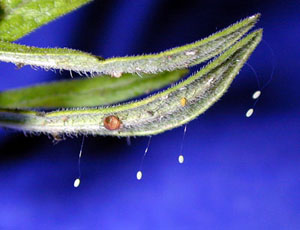Lacewings

Lacewings (Chrysopidae, Hemerobiidae) Both green lacewings and brown lacewings are predators, green lacewings are more common. They are often found on weeds, shrubs, and other cultivated plants. Adult green lacewings are about 3/4 inch, brown lacewings are smaller. Adult and larval brown lacewings and larval green lacewings feed on soft-bodied insects, especially aphids, and mites. Adult green lacewings may be pollen-feeders or they may be predaceous. Most are greenish in color with copper eyes and the network of veins in the wings that gives them their name.

Lacewing eggs are attached to leaves by a long hair-like stalk. This raises the eggs off the surface of the leaf and helps prevent cannibalism when the young predators hatch. Larvae are oblong and soft-bodied, with distinctive sickle-shaped mandibles. They are often called aphid lions, because of their habit of feeding on aphids. Some brown lacewings adhere the skins of their prey and other matter to their backs as a form of camouflage.
